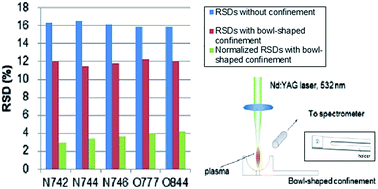Application of spatial confinement for gas analysis using laser-induced breakdown spectroscopy to improve signal stability
Abstract
The quantitative analysis of gaseous samples using laser induced breakdown spectroscopy (LIBS) is limited due to its relatively lower signal reproducibility compared with that of solid samples. In this study, a cylindrical spatial confinement was first applied to reduce the signal fluctuations in the analysis of ambient air using LIBS. With the aid of plasma image analysis, bowl-shaped confinements were further designed to reduce the signal fluctuations. The location and the size of the confinements were also optimized to achieve the best effect. Results show that a cylindrical confinement reduces the signal fluctuations to some extent. Compared with using the cylindrical confinement, the shape and position of the plasma are better stabilized and spectral fluctuations are further reduced by using a bowl-shaped confinement. Simply using the traditional spectral area normalization method to alleviate the influence of the variance in plasma energy, the pulse-to-pulse relative standard deviations (RSDs) can be reduced to 2.94% for nitrogen and 3.97% for oxygen, which are comparable to RSDs found in the analysis of solid samples.

- This article is part of the themed collection: Analytical atomic spectrometry in China

 Please wait while we load your content...
Please wait while we load your content...